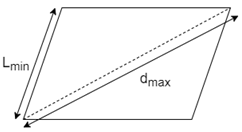This set of Finite Element Method Interview Questions and Answers for freshers focuses on “Conjugate Gradient Implementation of Quadrilateral Element”.
1. Which of the following elements are used for structural and fatigue analysis?
a) Triangular Elements
b) Quadrilateral Elements
c) Shell type Elements
d) Pentagonal Elements
View Answer
Explanation: Quadrilateral Elements are used for structural and fatigue analysis. Shell type Elements are used for dynamic analysis. Triangular Elements are used for mold flow analysis. Pentagonal elements can be used in CFD analysis.
2. In conjugate gradient implementation of quadrilateral elements the stiffness of each element is stored in three dimensional arrays.
a) True
b) False
View Answer
Explanation: The stiffness of each quadrilateral element is stored in three dimensional arrays. Thus stiffness of each element can be recalled without recalculating for iterations carried out.
3. The total number of dofs in quadrilateral element is ______
a) thirty six
b) eighteen
c) twenty four
d) forty two
View Answer
Explanation: Number of dofs per node=6
Number of nodes in quadrilateral element=4
Total number of dofs=6*4=24
4. Which of the following statement is false?
a) Linear quad element is more accurate than linear tria element
b) Linear tria element is more accurate than linear quad element
c) Parabolic elements are better than linear elements
d) Parabolic quad element has eight codes
View Answer
Explanation: As quad element has one more term in the displacement function than tria elements it is more accurate. The displacement function is u=a0+a1x+a2y+a3xy.
5. Which of the following statements about warp angle is not true?
a) It is a not applicable for tria elements
b) It is an angle formed between two normal of planes formed by splitting quad element along diagonal
c) Its value should be less than 10°
d) It is the minimum angle between the planes of diagonally split quad element
View Answer
Explanation: Warp angle is a quality check parameter mostly used in quad elements. It is the maximum value between the normal of planes formed by diagonally splitting quad elements.
6. Acceptable included angle for quad elements lies between 45° and 135°.
a) True
b) False
View Answer
Explanation: Included angle check is applied for individual angles and. Skew is based on overall shape and doesn’t take in account individual angles.
7. Which of the following is the correct expression for calculating skew of quadrilateral element?
a) Skew=90°+minimum angle formed by joining opposite mid sides of quad element
b) Skew=90°-minimum angle formed by joining opposite mid sides of quad element
c) Skew=90°*minimum angle formed by joining opposite mid sides of quad element
d) Skew=90°/minimum angle formed by joining opposite mid sides of quad element
View Answer
Explanation: Skew is a quality check parameter for quadrilateral elements. The ideal value of skew should be 0°. The value of skew is acceptable till 45°.
8. Which of the following is the correct expression for calculating skew of quadrilateral element?

a) Stretch=Lmin*(20.5/dmax)
b) Stretch=Lmin+(20.5/dmax)
c) Stretch=Lmin-(20.5/dmax)
d) Stretch=Lmin *(20.5+dmax)
View Answer
Explanation: The value of stretch is given by:
Stretch=Lmin*(20.5/dmax)
Here Lmin is length of minimum side of quad element, and dmax is the length of maximum diagonal of quad element. Ideally its value should be 1, but values greater than 0.2 are acceptable.
Sanfoundry Global Education & Learning Series – Finite Element Method.
To practice all areas of Finite Element Method for Interviews, here is complete set of 1000+ Multiple Choice Questions and Answers.
If you find a mistake in question / option / answer, kindly take a screenshot and email to [email protected]
- Check Civil Engineering Books
- Apply for Civil Engineering Internship
- Practice Civil Engineering MCQs
- Check Finite Element Method Books
- Check Mechanical Engineering Books
